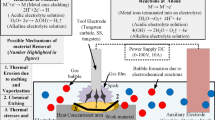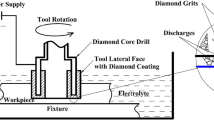Abstract
Electrochemical discharge machining (ECDM) is a promising hybrid process for high-performance machining of non-conductive glass. ECDM drilling has been found to have different characteristics and material removal mechanisms in discharge regime (less than 300 μm in depth) and hydrodynamic regime (more than 300 μm in depth); however, these regimes are never separately modeled in existing ECDM models, which leads to large prediction error, especially at low applied voltages and high machining depths. Until now, no model is particularly designed for discharge regime, where most material is removed. In this paper, a finite element based model for ECDM drilling in discharge regime is presented. Material removal subjected to a single spark was simulated using finite element method. The drilling depth evolution in discharge regime was predicted. The model predictions were compared with experimental results for validation. The fraction of power transferred to workpiece was found to be about 29% in discharge regime.
Similar content being viewed by others
References
Kurafuji H, Suda K (1968) Electrical discharge drilling of glass. Ann CIRP 16:415–419
Wang MH, Zhu D (2009) Fabrication of multiple electrodes and their application for micro-holes array in ECM. Int J Adv Manuf Technol 41:42–47
Wüthrich R, Fascio V (2005) Machining of non-conducting materials using electrochemical discharge phenomenon—an overview. Int J Mach Tools Manuf 45:1095–1108
Zheng ZP, Cheng WH, Huang FY, Yan BH (2007) 3D microstructuring of Pyrex glass using the electrochemical discharge machining process. J Micromech Microeng 17:960–966
Jain VK, Adhikary S (2008) On the mechanism of material removal in electrochemical spark machining of quartz under different polarity conditions. J Mater Process Technol 200:460–470
Fascio V, Wüthrich R, Bleuler H (2004) Spark assisted chemical engraving in the light of electrochemistry. Electrochim Acta 49:3997–4003
Wüthrich R, Hof LA (2006) The gas film in spark assisted chemical engraving (SACE)—a key element for micro-machining applications. Int J Mach Tools Manuf 46:828–835
Cheng CP, Wu KL, Mai CC, Yang CK, Hsu YS, Yan BH (2010) Study of gas film quality in electrochemical discharge machining. Int J Mach Tools Manuf 50:689–697
Basak I, Ghosh A (1997) Mechanism of material removal in electrochemical discharge machining: a theoretical model and experimental verification. J Mater Process Technol 71:350–359
Yang CT, Ho SS, Yan BH (2001) Micro hole machining of borosilicate glass through electrochemical discharge machining (ECDM). Key Eng Mater 196:149–166
Jalali M, Maillard P, Wüthrich R (2009) Toward a better understanding of glass gravity-feed micro-hole drilling with electrochemical discharges. J Micromech Microeng 19:045001
Panda MC, Yadava V (2009) Finite element prediction of material removal rate due to traveling wire electrochemical spark machining. Int J Adv Manuf Technol 45:506–520
Wüthrich R, Spaelter U, Wu Y, Bleuler H (2006) A systematic characterization method for gravity feed micro-hole drilling in glass with spark assisted chemical engraving (SACE). J Micromech Microeng 16:1891–1896
Sarkar BR, Doloi B, Bhattacharyya B (2006) Parametric analysis on electrochemical discharge machining of silicon nitride ceramics. Int J Adv Manuf Technol 28:873–881
Chak SK, Rao PV (2008) The drilling of Al2O3 using a pulsed DC supply with a rotary abrasive electrode by the electrochemical discharge process. Int J Adv Manuf Technol 39:633–641
Wei CJ, Ni J, Hu DJ (2010) Electrochemical discharge machining using micro-drilling tools. Transactions of the North American Manufacturing Research Institute of SME, Society of Manufacturing Engineers, Dearborn, MI, pp 105–111
Jain VK, Dixit PM, Pandey PM (1999) On the analysis of the electrochemical spark machining process. Int J Mach Tools Manuf 39:165–186
Bhondwe KL, Yadava V, Kathiresan G (2006) Finite element prediction of material removal rate due to electro-chemical spark machining. Int J Mach Tools Manuf 46:1699–1706
Izquierdo B, Sanchez JA, Plaza S, Pombo I, Ortega N (2009) A numerical model of the EDM process considering the effect of multiple discharges. Int J Mach Tools Manuf 49:220–229
Maillard P, Despont B, Bleuler H, Wüthrich R (2007) Geometrical characterization of micro holes drilled in glass by gravity-feed with spark assisted chemical engraving (SACE). J Micromech Microeng 17:1343–1349
Mousa M, Allagui A, Ng HD, Wüthrich R (2009) The effect of thermal conductivity of the tool electrode in spark-assisted chemical engraving gravity-feed micro-drilling. J Micromech Microeng 19:015010
Kulkarni A, Sharan R, Lal GK (2003) Measurement of temperature transients in the electrochemical discharge machining process. Temperature: its measurement and control in science and industry, vol 7. Eighth Temperature Symposium, AIP Conference Proceedings, Melville, NY, pp 1069–1074
Author information
Authors and Affiliations
Corresponding author
Rights and permissions
About this article
Cite this article
Wei, C., Xu, K., Ni, J. et al. A finite element based model for electrochemical discharge machining in discharge regime. Int J Adv Manuf Technol 54, 987–995 (2011). https://doi.org/10.1007/s00170-010-3000-0
Received:
Accepted:
Published:
Issue Date:
DOI: https://doi.org/10.1007/s00170-010-3000-0




